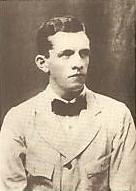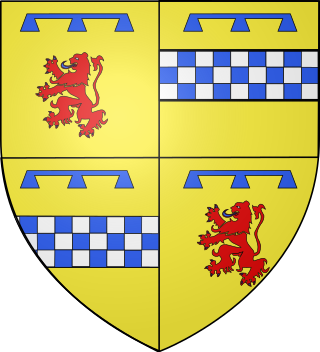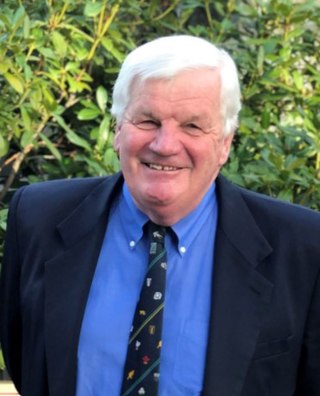Origins
The first of the family to combine the two names was the schoolmaster Robert Bruce Lockhart (1858—18 Nov 1949), born at Montreal in Upper Canada and a graduate of the University of Edinburgh, who was the son of Robert Arthur Lockhart (1832–1904) and Annabella Wilson (1833–1888), both of whom had been born in Glasgow and died in Edinburgh. [1] [2] His mother was a daughter of William Wilson and Annabella Bruce (1807–1884) herself a daughter of James Hamilton Bruce (1783–1823), who was a great-great-grandson of Alexander Bruce, 2nd Earl of Kincardine. He was descended from Thomas Bruce, 1st Baron of Clackmannan, as are most Bruces, including the Chiefs of Clan Bruce. Thomas Bruce is known to have been related to Robert the Bruce (1274–1329), king of Scotland, but how is not clear. [3] [4]
Lockhart was headmaster of several schools: first the Waid Academy, at Anstruther, then Spier's School, Beith, a new school. In 1895 he founded Seafield House Preparatory School at Broughty Ferry, and in 1906 bought Eagle House School, at Sandhurst, Berkshire. [1] For Lockhart, the name Bruce was a middle Christian name, celebrating distinguished ancestors, [5] and most of his sons also had it as a middle name, their surname as registered at the General Register Office remaining simply Lockhart. However, by the use of the name by almost all the men of the family, and later by all its daughters, too, the name Bruce has come to be regarded as part of the surname, in some cases leading to the adoption of a hyphen.

Lord Balfour of Burleigh, in the County of Kinross, is a title in the Peerage of Scotland. It was created in 1607 for Sir Michael Balfour.

Sir Robert Hamilton Bruce Lockhart, KCMG was a British diplomat, journalist, author, and secret agent. His 1932 book Memoirs of a British Agent became an international bestseller by telling of his experiences in Russia in 1918 following the Bolshevik Revolution. He left the country after he was accused of having led a failed plot to assassinate Vladimir Lenin, the so-called Ambassadors' plot, a charge which he always denied. Later research suggests that the "Lockhart Plot" was a sting operation orchestrated by Felix Dzerzhinsky with the goal of discrediting the British and French governments.

General Sir Rob McGregor MacDonald Lockhart was a senior British Army officer during the Second World War and later the first Commander-in-Chief of the Indian Army upon India's independence.

Alexander John Bruce-Lockhart, Baron Bruce-Lockhart,, commonly known as Sandy Bruce-Lockhart, was a British Conservative politician and a senior figure in English local government. He was the leader of Kent County Council and then Chairman of the Local Government Association. He was succeeded in the latter post by Simon Milton, ex-Leader of Westminster Council.

Walter Stewart, Earl of Atholl, Strathearn and Caithness was a Scottish nobleman, the son of Robert II of Scotland. Stewart advocated for the ransom and return to Scotland of the future king in exile, James I, in 1424. In 1425 he served as a member of the jury of 21 which tried and executed his nephew Murdoch Stewart, 2nd Duke of Albany. Eventually, however, Atholl turned against the King and conspired in his assassination in 1437. He was tried for murder and was executed after three days of torture.

James Mor Stewart, called James the Fat, was the youngest son of Murdoch Stewart, Duke of Albany and Isabella of Lennox. When his father and brothers were executed by King James I for treason in 1425, James led a rebellion against the king, taking the town of Dumbarton and killing the keeper of Dumbarton Castle. His success was short lived and he soon fled to Ireland, where he would spend the remainder of his life in exile. A second attempt at rebellion in 1429 saw a fleet sail to Ireland to collect James "to convey him home that he might be king", but he died before the attempt could be made.
Logie Bruce Lockhart was a Scottish schoolmaster, writer, and journalist, in his youth a Scottish international rugby union footballer and for most of his teaching career headmaster of Gresham's School.
Dugald Bruce Lockhart is an Anglo-Scottish stage and screen actor, director and writer.

Cargilfield Preparatory School is a Scottish private co-educational boarding and prep school in Edinburgh, Scotland.
John Harold "J.H." Bruce Lockhart was a Scotland international cricket player; and a Scotland international rugby union player. He became a schoolmaster. He was part of the noted Bruce Lockhart family.

Campbell Richard Hone was an eminent Anglican bishop in the second quarter of the 20th century.

Carter-Campbell of Possil is a branch of Clan Campbell, a Scottish clan. Historically, they are part of Clan Campbell, which was regarded as one of the largest Scottish clans. The branch of the Campbell clan was historically centred in Lawers. Some of the clan, which originated with the original Campbells, had links to the lands of Argyll.
Rab Brougham Bruce Lockhart was a Scottish soldier and schoolmaster, notable for his sporting career as a Scotland international at rugby union and as a member of the Scotland national cricket team. He became headmaster of Wanganui Collegiate School in New Zealand and later of Loretto School in Scotland.
Sir Colin Og Campbell of Lochawe, also known as Cailean Óg Caimbeul, Sir Colyn Cambel, Colin the Young, and Coline Oig Campbell, was an early member of Clan Campbell and patrilineal ancestor of the Earls of Argyll. He was lord of Lochawe and Ardscotnish from 1316 until his death sometime before 1343.

Alistair Kim Bruce-Lockhart was a Scottish professional squash player from the Bruce Lockhart family.
John Macgregor Bruce Lockhart OBE CMG CB was a British schoolmaster, soldier, diplomat, intelligence officer, and university administrator.
Patrick Bruce Lockhart was a Scottish-born obstetrician-gynaecologist who worked in Scotland, India, England, and Canada.
James Robert "Jamie" Bruce Lockhart was a British diplomat, intelligence officer, author, and artist. The son of diplomat J. M. Bruce Lockhart and grandson of Scottish rugby international John Bruce Lockhart, he gained a modern languages degree from the University of Cambridge before beginning a career with the Foreign Office. However, this work was in fact a cover for his real work with the Secret Intelligence Service (MI6). In later years, Lockhart became a published author, with works including a biography of Hugh Clapperton and a book about life in an English preparatory school. He was the father of actor Dugald Bruce Lockhart.

Simon C. Bruce-Lockhart, is a Scottish-Canadian schoolmaster who taught at several schools in Canada between 1972 and 2015.
Sir Robert Neil Campbell KCMG CB CIE was a Scottish physician whose career was in British India.













